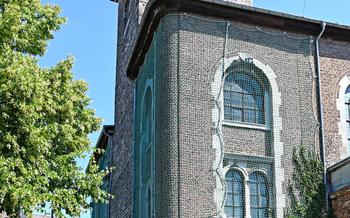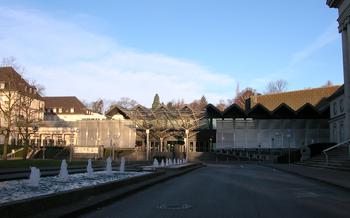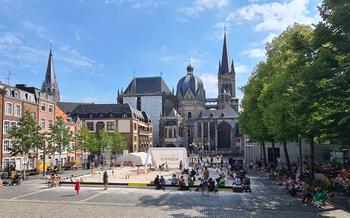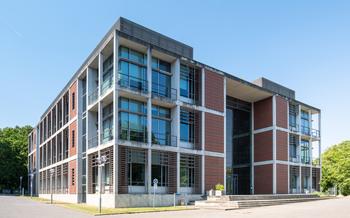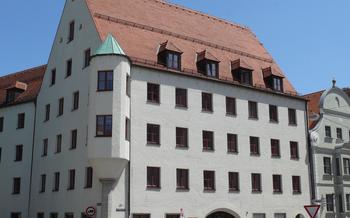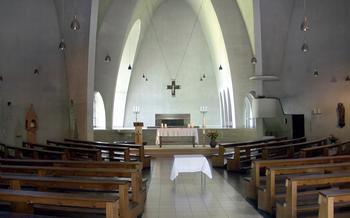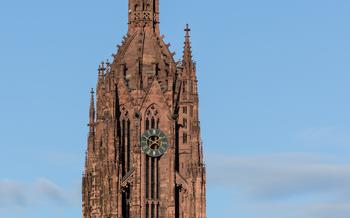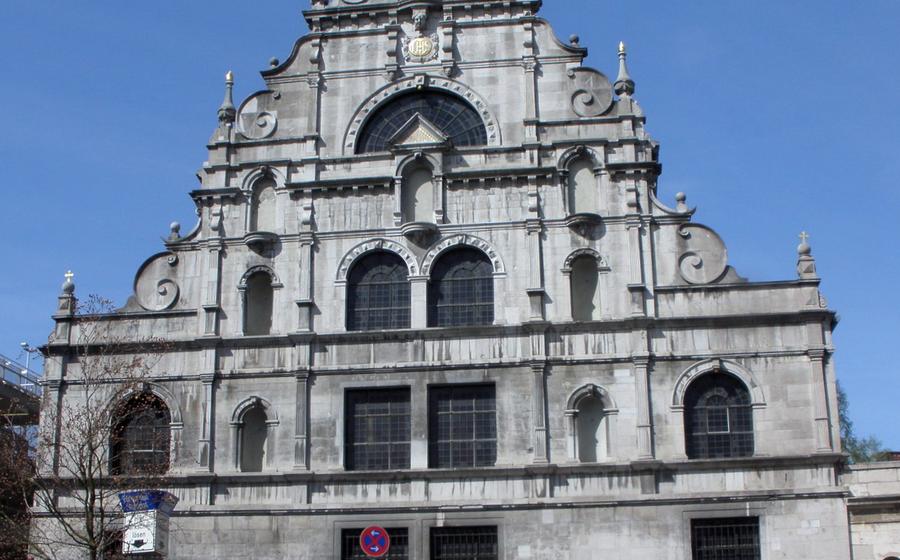
Jesuit Church of St. Michael
- Historical Significance
- Architectural Features
- Religious Significance
- Cultural Impact
- Historical Events
- Legends and Folklore
- Restoration and Preservation
- Visiting Information
- Things to See and Do Nearby
- Photography Tips
- Local Cuisine and Restaurants
- Accommodation Options
- Souvenir Shopping
- Accessibility and Facilities
- Insider Tip: Discover the Hidden Crypt
Historical Significance
The Jesuit Church of St. Michael, a majestic edifice in the heart of Aachen, Germany, holds a profound significance in the city's history and religious landscape. Constructed between 1622 and 1664, the church stands as a testament to the architectural prowess of the Jesuit order and the cultural influences that shaped Aachen during the Baroque era. Its striking facade, intricate interior, and numerous historical associations make it a must-visit destination for anyone interested in exploring the city's rich heritage.
The church's construction was initiated by Emperor Ferdinand II, who sought to establish a Jesuit college in Aachen to counter the growing influence of Protestantism in the region. The Jesuits, known for their educational and missionary work, were entrusted with the task of building the church and the adjacent college. The result was a magnificent structure that showcased the architectural principles of the Counter-Reformation, blending elements of Gothic and Renaissance styles.
The church's prominent location, facing the historic Elisenbrunnen fountain, further underscores its importance in Aachen's urban development. It served as a focal point for religious processions, public gatherings, and civic events, solidifying its role as a central landmark in the city. Over the centuries, the Jesuit Church of St. Michael has borne witness to countless historical events, including coronations, imperial visits, and religious festivals, becoming an integral part of Aachen's collective memory.
Architectural Features
The Jesuit Church of St. Michael in Aachen, Germany, stands as a testament to the city's rich architectural heritage. Its exterior facade, adorned with intricate carvings and sculptures, captivates the eye with its Gothic-Renaissance style. The two towering spires, reaching towards the sky, add a majestic touch to the church's silhouette.
Inside, the church unfolds in a harmonious symphony of architectural elements. The nave, with its soaring height and elegant arches, creates a sense of awe and grandeur. The side aisles, lined with delicate columns, lead the eye towards the intricate stained glass windows, whose vibrant hues cast a mystical glow upon the interior.
The church's stained glass windows, a masterpiece of artistry, depict biblical scenes and religious figures with remarkable detail and craftsmanship. Each window tells a story, immersing visitors in the rich history and iconography of the Catholic faith.
The walls of the church are adorned with frescoes and sculptures, adding to its visual splendor. These artworks, created by skilled artisans, depict scenes from the life of Christ, the saints, and other religious themes. The intricate carvings on the pulpit and the altar, showcasing the mastery of Baroque craftsmanship, are particularly noteworthy.
Religious Significance
The Jesuit Church of St. Michael holds immense religious significance for the city of Aachen and the surrounding region. As a place of worship, it serves as a spiritual center for the local Catholic community. Throughout its history, the church has been a site of pilgrimage and devotion, attracting believers from near and far who seek solace, guidance, and a connection with the divine.
Within the church, visitors can admire numerous religious artifacts, including intricately carved altars, delicate statues of saints, and beautifully crafted stained glass windows. These elements contribute to the sacred atmosphere of the church, inviting contemplation and reflection. The church also hosts regular masses, special services, and religious festivals, providing opportunities for the faithful to come together in prayer and celebration.
Notable religious figures associated with the church include Father Franz Xaver, a Jesuit missionary who spent time in Aachen and is known for his work in spreading Christianity in East Asia. His legacy continues to inspire the church's commitment to global outreach and interfaith dialogue.
Cultural Impact
The Jesuit Church of St. Michael has played a pivotal role in shaping the cultural identity of Aachen. Its grand architecture and rich history have inspired generations of artists, musicians, writers, and other cultural figures. The church's unique blend of Baroque and Gothic elements has influenced the design of other buildings and structures in the city, creating a cohesive architectural landscape.
Throughout the centuries, the church has hosted numerous concerts, performances, and exhibitions, showcasing the talents of local and international artists. The church's acoustics are particularly renowned, making it an ideal venue for choral music and organ recitals. The church's interior is adorned with a collection of stunning stained glass windows, which depict scenes from the Bible and the lives of saints. These windows have been a source of inspiration for many local artists and have been featured in numerous paintings and other works of art.
The church has also been a muse for writers and poets, who have found inspiration in its beauty and spirituality. Many famous German writers, such as Heinrich Böll and Günter Grass, have written about the church in their works. The church's unique atmosphere has also attracted filmmakers and photographers, who have captured its essence in documentaries, movies, and photographs.
Historical Events
The Jesuit Church of St. Michael has witnessed many significant historical events throughout its existence. During the First World War, the church served as a military hospital, providing medical care to wounded soldiers from both sides of the conflict. The city of Aachen also suffered significant damage during the Second World War, but the church miraculously survived the bombings and remained intact. In 1978, Pope John Paul II visited the church during his pilgrimage to Germany, where he celebrated a mass and delivered a sermon to the congregation. This visit was a momentous occasion for Aachen and the Jesuit community, further solidifying the church's religious and historical significance.
Legends and Folklore
The Jesuit Church of St. Michael is steeped in legends and folklore that have captured the imagination of locals and visitors alike for centuries. One of the most well-known legends is the story of the "Devil's Stone." According to the tale, the devil himself tried to prevent the construction of the church by throwing a massive stone at the site. However, the stone miraculously missed its target and landed in a nearby field, where it remains to this day. Visitors can still see the Devil's Stone, which is now a protected historical monument, and marvel at the legend that surrounds it.
Another popular legend associated with the church is the story of the "Golden Madonna." It is said that during the Middle Ages, the church was home to a beautiful golden statue of the Virgin Mary. However, during a time of war, the statue was stolen by enemy forces. The people of Aachen were devastated by the loss, but they never gave up hope of finding it. According to legend, the statue will one day be returned to the church, signaling the return of peace and prosperity to the city.
These legends and folklore have been passed down through generations and have become an integral part of the cultural identity of Aachen. They reflect the deep religious beliefs and the rich imagination of the local people. Visitors to the Jesuit Church of St. Michael can immerse themselves in these stories and experience the magic and mystery that surrounds this historic landmark.
Restoration and Preservation
The Jesuit Church of St. Michael has undergone extensive restoration and preservation efforts throughout its history. In the 19th century, the church underwent a major renovation that involved the restoration of its interior and exterior. During this time, the original Baroque decoration was revived, and the church's stained glass windows were repaired or replaced. In the 1960s, the church underwent another round of restoration, which focused on addressing structural issues and preserving the church's historical features. More recently, in the early 21st century, the church's exterior was meticulously restored, involving the cleaning and repair of the stonework and the replacement of damaged elements. These ongoing efforts to restore and preserve the Jesuit Church of St. Michael ensure that this architectural masterpiece continues to stand as a testament to the city's rich history and cultural heritage.
Visiting Information
To fully appreciate the grandeur of the Jesuit Church of St.
Things to See and Do Nearby
In addition to exploring the Jesuit Church of St. Michael, visitors can discover a wealth of other attractions and activities in the surrounding area. History buffs can delve into the city's rich past at the Aachen Cathedral Treasury, which houses a fascinating collection of religious artifacts and treasures. Art enthusiasts will appreciate the Ludwig Forum for International Art, showcasing contemporary exhibitions from renowned artists worldwide.
For those seeking a taste of nature, the Botanical Garden Aachen offers a tranquil oasis with diverse plant species and serene walking paths. Shopaholics can indulge in retail therapy at the Aquis Plaza, a modern shopping center featuring a wide range of stores and boutiques.
To enhance your visit, consider joining a guided tour of Aachen's Old Town, where you can learn about the city's captivating history and admire its architectural wonders. For a unique perspective, embark on a boat trip along the Wurm River, offering picturesque views of the city skyline.
Plan your itinerary strategically to combine your visit to the Jesuit Church of St. Michael with other attractions that align with your interests. Whether you're passionate about history, art, nature, shopping, or local culture, Aachen has something to offer every traveler.
Photography Tips
To capture the grandeur and beauty of the Jesuit Church of St. Michael through photography, here are some tips to enhance your shots:
Choose the Right Time: The best time to photograph the church is during the golden hours, just after sunrise or before sunset, when the warm, diffused light casts a magical glow on the building's facade.
Find the Ideal Angle: Experiment with different angles to find the most flattering perspective. Try shooting from a low angle to emphasize the church's towering height, or from a distance to capture its full majesty.
Pay Attention to Details: Focus on the intricate details of the church's architecture, such as the delicate carvings on the portal, the ornate stained glass windows, or the intricate frescoes adorning the interior.
Use a Tripod: To ensure sharp and steady shots, especially in low-light conditions, use a sturdy tripod to stabilize your camera.
Capture the Interior: While the exterior of the church is impressive, don't forget to capture the breathtaking interior. Use a wide-angle lens to fit in the vastness of the nave and the intricate details of the vaulted ceilings.
Experiment with Filters: To add depth and drama to your photos, experiment with different filters. Try a polarizing filter to reduce reflections and enhance colors, or a neutral density filter to create a sense of movement in the clouds.
Be Respectful: Remember that the church is an active place of worship, so be respectful of ongoing services or ceremonies. Always ask permission before photographing people, and be mindful of your surroundings.
Local Cuisine and Restaurants
A visit to Aachen wouldn't be complete without savoring the local culinary delights. When it comes to dining, Aachen offers a diverse range of restaurants and cafes catering to various tastes and budgets. To experience the true essence of German cuisine, try traditional dishes like "Aachener Printen," a delicious gingerbread specialty, or "Reibekuchen," a savory potato pancake. For a taste of international flavors, explore the many ethnic restaurants serving Italian, Greek, or Asian cuisines.
Indulge in the local dining culture by visiting traditional German restaurants, known as "Gaststätten." These cozy establishments often feature wooden interiors, warm hospitality, and hearty dishes like "Schnitzel," a breaded and fried cutlet, or "Sauerbraten," a slow-cooked beef dish. Be sure to try the local beer, which is brewed according to the German Purity Law of 151
When dining out in Germany, it's customary to greet the waiter or waitress with a friendly "Guten Tag" (Good day) and say "Danke" (Thank you) when leaving. Tipping is generally expected, with a 5-10% gratuity being the norm.
Accommodation Options
Aachen offers a diverse range of accommodation options to suit every budget and preference. Whether you seek budget-friendly hostels, comfortable guesthouses, or luxurious hotels, you're sure to find something that meets your needs.
For backpackers and budget-conscious travelers, the city center offers several hostels with dormitory-style rooms and shared facilities. These hostels often provide a social atmosphere and are a great way to meet fellow travelers.
If you prefer a more private and comfortable stay, consider booking a room at a guesthouse or a small hotel. These establishments typically offer cozy rooms with private bathrooms and basic amenities. They are often family-run and provide a more personalized experience.
For a truly luxurious experience, Aachen boasts several upscale hotels that offer elegant rooms, fine dining, and top-notch amenities. These hotels are ideal for travelers who seek comfort, convenience, and a touch of indulgence.
When choosing your accommodation, consider the location carefully. The city center is ideal for those who want to be close to the main attractions, including the Jesuit Church of St. Michael. However, if you're on a tight budget or prefer a quieter atmosphere, consider staying in one of the charming neighborhoods outside the city center, such as Burtscheid or Frankenberg.
No matter where you choose to stay, booking your accommodation in advance is always advisable, especially during peak tourist season. This will ensure that you have a place to stay upon arrival and avoid any last-minute surprises.
Souvenir Shopping
After exploring the Jesuit Church of St. Michael, you may want to take home a souvenir to remember your visit. Aachen offers a variety of shops and markets where you can find unique and meaningful items related to the church and the city.
One popular souvenir is the Aachener Printen, a traditional gingerbread cookie with a rich history dating back to the Middle Ages. These cookies are often decorated with intricate designs and are a delicious treat to enjoy or share with friends and family.
Another popular choice is religious artifacts, such as rosaries, crucifixes, or statues of saints. These items can be found in many of the shops near the church, and they make a thoughtful gift for those who are interested in the religious significance of the site.
For those looking for something more unique, there are several local crafts and traditions that are reflected in the souvenirs available in Aachen. For example, you can find hand-painted ceramics, glassware, and textiles that showcase the city's rich cultural heritage.
When shopping for souvenirs, be sure to visit the Aachener Markt, a vibrant outdoor market that takes place on Tuesdays, Thursdays, and Saturdays. Here, you can browse a variety of stalls selling fresh produce, local crafts, and souvenirs, all while experiencing the lively atmosphere of the city.
Accessibility and Facilities
The Jesuit Church of St. Michael is committed to providing an inclusive and accessible environment for all visitors, regardless of their abilities or disabilities. Wheelchair ramps and elevators are available to ensure that everyone can easily access the church's interior. Accessible restrooms are also provided for the convenience of visitors with special needs. If you require any additional assistance or accommodations, please feel free to contact the church in advance. The friendly staff will be more than happy to assist you and ensure that you have a comfortable and enjoyable visit.
Insider Tip: Discover the Hidden Crypt
Beneath the Jesuit Church of St. Michael lies a hidden gem—a crypt that has remained largely unknown to visitors. This atmospheric underground chamber is accessible through a discreet door in the church's sacristy. Descend the stone steps and you'll find yourself in a dimly lit space filled with ancient tombs, elaborate carvings, and faded frescoes. The crypt is the resting place of prominent figures from Aachen's past, including former church officials, wealthy benefactors, and even a few notable citizens. As you wander through the crypt, you'll feel a sense of awe and reverence for the history that surrounds you. It's a unique opportunity to glimpse into the lives and legacies of those who have shaped Aachen's rich heritage. So, if you're looking for an off-the-beaten-path experience, don't miss the chance to explore the hidden crypt of the Jesuit Church of St. Michael.

